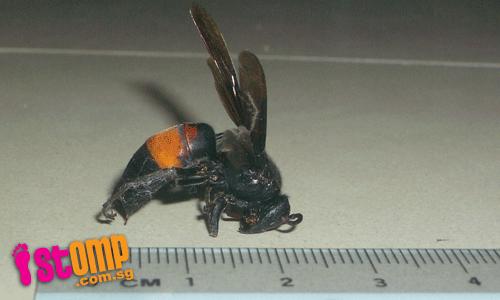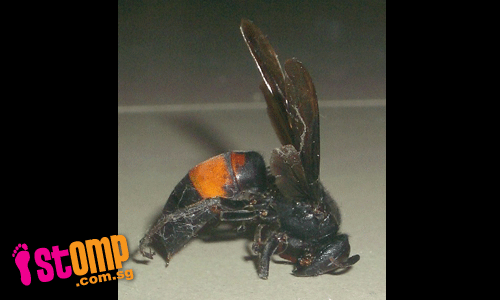
These gigantic insects have been flying into STOMPer Reine's house frequently.
Reine is unable to identify these insects and wonders whether they are dangerous.
This STOMPer says:
"Since last month, this is the 3rd time such a gigantic insect has flown into my house.
"Luckily all three succumbed to insecticide.
"They have a special affinity to the lightings in the house.
"They made a clear and crisp sound when their bodies hit against the casing of the lighting fixtures.
"Anyone knows these insects are? Are they dangerous?
"They seem to have a needle-like tip at the end of their body."

Related posts: "It only took 12 hours for these bees to infest my house toilet" (24th April 2009)
Bees, bees and more bees at Clementi! (6th April 2009)
Several beehives in overhead bridge leading to SGH (16th February 2009)
It is possible that there might be a colony of lesser banded hornets (Vespa affinis) nearby, which would explain all these hornets flying into this person's home.
Hornets, like honeybees and ants, are eusocial and live in large colonies.
According to the excellent Asian Hornet Net:
Social wasps build their nests with paper-like fibres, which are made out of wood pulp. They bite and tear fragments from tree trunks, rotting logs, plant fibres and even wooden man-made structures, then chew the fragments and mix them with saliva till they are soft. This material is then applied in layers to the surface, and dries to form a tough, fairly strong paper.
The adult wasps themselves feed on nectar from flowers or other sweet liquids, and also on a type of fluid produced by the larvae. Most wasps (queens and reproductive females being a possible exception) are unable to digest protein themselves. It is the larvae that are carnivorous, and the workers catch many insects every day to feed them. In this way they are useful as they capture many pest species in the process. However, some species may be pests to beekeepers by capturing honeybees.

Lesser banded hornet killing Asian honeybee (Apis cerana);
Local hornets can be seen scavenging on leftovers and carrion, although it is possible that the hornets' main objective is to ambush and catch the flies that are also attracted to them.

Lesser banded hornet scavenging on prawn used as bait for fishing, Pasir Ris;


Lesser banded hornets ambushing flies drawn to stranded green mussels (Perna viridis), Changi;
The risk to human safety is minimal, as several accounts state that hornets are relatively docile when out foraging. It is only when the colony is under threat that hornets become aggressive and attack en masse. Still, it is understandable that most people are uncomfortable with hornets living in close proximity, especially if there are individuals with potentially dangerous allergic reactions to bee and wasp stings.
Lately, one very interesting area of research focuses on interactions between hornets and their relatives, the honeybees (Apis spp.). Hornets can be significant predators of honeybees and their larvae, which is bad news in areas that depend on honeybees for crop pollination and honey production.
The Japanese subspecies of the Asian giant hornet (Vespa mandarinia japonica) has earned a fearsome reputation; not only is this the world's largest hornet species, but the infamous ability of a couple of dozen hornets to decimate an entire honeybee colony has made this hornet a favourite of nature documentaries.
The content in the videos above is quite repetitive, but it can be clearly seen just how defenseless European honeybees (Apis mellifera) are against the marauding giant hornets. Even yellow hornets (Vespa simillima) don't seem to stand a chance against their giant kin.
The European honeybee is the most widely used species in beekeeping, and has been introduced to countries far beyond its native range. Its close relative the Asian honeybee (Apis cerana) has already been domesticated on a smaller scale for millenia, but the amount of honey produced by the latter is smaller than that of the European honeybee. This is due to the fact that Asian honeybees tend to have smaller colonies, and also because this species has not been subjected to the heavy selective breeding that has been carried out on European honeybees.
In Japan, European honeybees may trump the native Asian honeybees in terms of honey output, but they are very vulnerable to attack by giant hornets. Having been introduced only recently, the European honeybees have yet to evolve an effective defence against the marauding giant hornets.
The Japanese honeybee (Apis cerana japonica), on the other hand, has found an unusual but effective tactic to deal with hornet raids.
As the videos explain, the Asian honeybees surround the hornet, forming a ball. By vibrating their wing muscles, the honeybees then raise the temperature in the middle of the ball, baking the hornet alive.
However, recent research has revealed that there is more to this story; the hornets are killed after being surrounded by bees for 10 minutes at 45 degrees Celsius. However, they are able to survive an incubator at 47 degrees for far longer than that. Something else must be happening to lower the hornet's heat tolerance when the Japanese honeybees launch their counterattack.
It turns out that the bees not only raise the temperature, but also increase the concentration of carbon dioxide. Within the ball of bees, the carbon dioxide level increases to a whopping 3.6%. At these elevated levels, the upper limit of the hornet's heat tolerance is reduced, bringing it within the temperature range of a honeybee heat-ball.
In Cyprus, the endemic subspecies of European honeybee (Apis mellifera cypria) carries out a similar tactic against the local hornet species, the Oriental hornet (Vespa orientalis). In this case, however, the hornet's heat tolerance matches that of the honeybees. What happens instead is that the honeybees surround the hornet and prevent it from expanding its abdomen. This interferes with the ability of the spiracles to absorb oxygen, causing the hornet to suffocate to death.
Returning to the topic at hand, yes, hornets can be dangerous, but the risk is somewhat exaggerated. If the colony is found and removed (or destroyed), it's likely that the visits will stop. Otherwise, keeping the windows on that side of the house shut should be another effective deterrent.